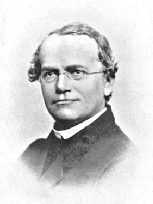« Prev Next »

Gregor Mendel: A Private Scientist

The Father of Genetics. Like many great artists, the work of Gregor Mendel was not appreciated until after his death. He is now called the "Father of Genetics," but he was remembered as a gentle man who loved flowers and kept extensive records of weather and stars when he died. He was born on July 22, 1822, to a poor farming family who lived in a village in Northern Moravia, which is now part of the Czech Republic. His family valued education but had little resources to send him to school, so he struggled to pay for his education.
Mendel becomes a monk. His professor recommended Mendel to the Augustinian monks in Brunn (now Brno), who valued science, research, and education. His professor thought he would be a good candidate because of his talent in physics and mathematics. Even though Mendel had not planned to be a monk, he was admitted to the order on September 7, 1843.
Mendel was then able to continue his education at the University of Vienna where he found a talent for teaching, though interestingly he was twice unable to pass the teaching certificate examination. He was quiet and shy; he may have found the oral part of the examination too nerve-wracking. He was at home in the monastery's botanical garden where he spent many hours a day breeding fuchsias and pea plants.
Mendel's brilliance is unrecognized. On February 8, 1865, Mendel presented his work to the Brunn Society for Natural Science. His paper, "Experiments on Plant Hybridization," was published the next year. While his work was appreciated for its thoroughness, no one seemed to grasp its importance. The work was simply too ahead of its time, too contrary to popular beliefs about heredity. "My time will come," Mendel once said, but it was over 30 years before his work was appreciated.
Further Exploration
Key Questions





















